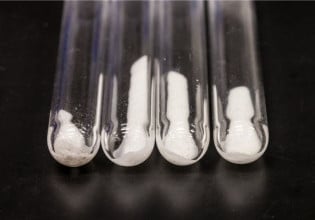Single IC Integrates Sensing, Energy-Harvesting, and Energy Storage
Researchers at King Abdullah University of Science and Technology (KAUST) have successfully combined sensing, energy-harvesting, current-rectifying, and energy-storage functions into a single microchip. (See the image above of the thin-film chip with the energy-storing microsupercapacitors arrayed along top and bottom).
"Previously, researchers had to use bulky rectifiers that converted intermittent harvested electrical energy into steady direct current for storage in electrochemical micro-supercapacitors," said Mrinal K. Hota, a research scientist at KAUST and lead author of the study.
Hota explained that the solution to integrating everything into a single chip was the use of ruthenium oxide (RuO2) as the common electrode material that connects all devices in the microcircuits. The team envisions a broad range of uses for the technology from monitoring the human body's personal health indicators directly to industrial and environmental sensing.
The researchers outlined the development in the journal, Advanced Materials.
"Our achievement simplifies device fabrication and realizes significant miniaturization of self-powered sensor devices," said project leader Husam Alshareef.
The ruthenium-oxide contacts were deposited onto a glass or silicon substrate. They used the material to connect sensing, energy-harvesting and current-rectifying electronics with one or more electrochemical microsupercapacitors that store the electrical energy. This enables a tiny system that can run without any battery power. Instead, it generates electricity from machinery vibrations or available body movement that serve as the reliable and continual source of energy.
"Unlike a battery, electrochemical microsupercapacitors can last for hundreds of thousands of cycles rather than just a few thousand," Hota points out. They can also deliver a significantly higher power output from a given volume.
An answer to creating electrode material suitable for connecting all devices was to make optimal ruthenium-dioxide surfaces with controlled roughness, defects, and conductivity. These features allowed the team to use RuO2 for both electronics and electrochemical microsupercapacitors.
Another critical technology innovation was to use a gel that, after application, solidifies into the supercapacitors' electrolyte. This unique material transports electric charge in the form of ions. The solidified gel was selected to avoid any damage to rectifiers and thin-film transistors.
The researchers now intend to work on optimizing the RuO2 electrodes further and exploring the linking many different sensor types into their chips.
They also want to study adding wireless communication into the device. This would let biosensors and environmental sensors send data remotely to any wireless receivers such as mobile phones and personal computers.
KAUST's Prof. Khaled Salama and Prof. Z.L. Wang from the Georgia Institute of Technology in Atlanta, USA were also part of the team led by Professor Husam Alshareef.
References Materials
Hota, M. K., Jiang, Q., Wang, Z., Wang, Z. L., Salama, K. N. & Alshareef, H. N. Integration of electrochemical micro-supercapacitors with thin-film electronics for on-chip energy storage. Advanced Materials 31, 1807450 (2019).| https://doi.org/10.1002/adma.201807450






